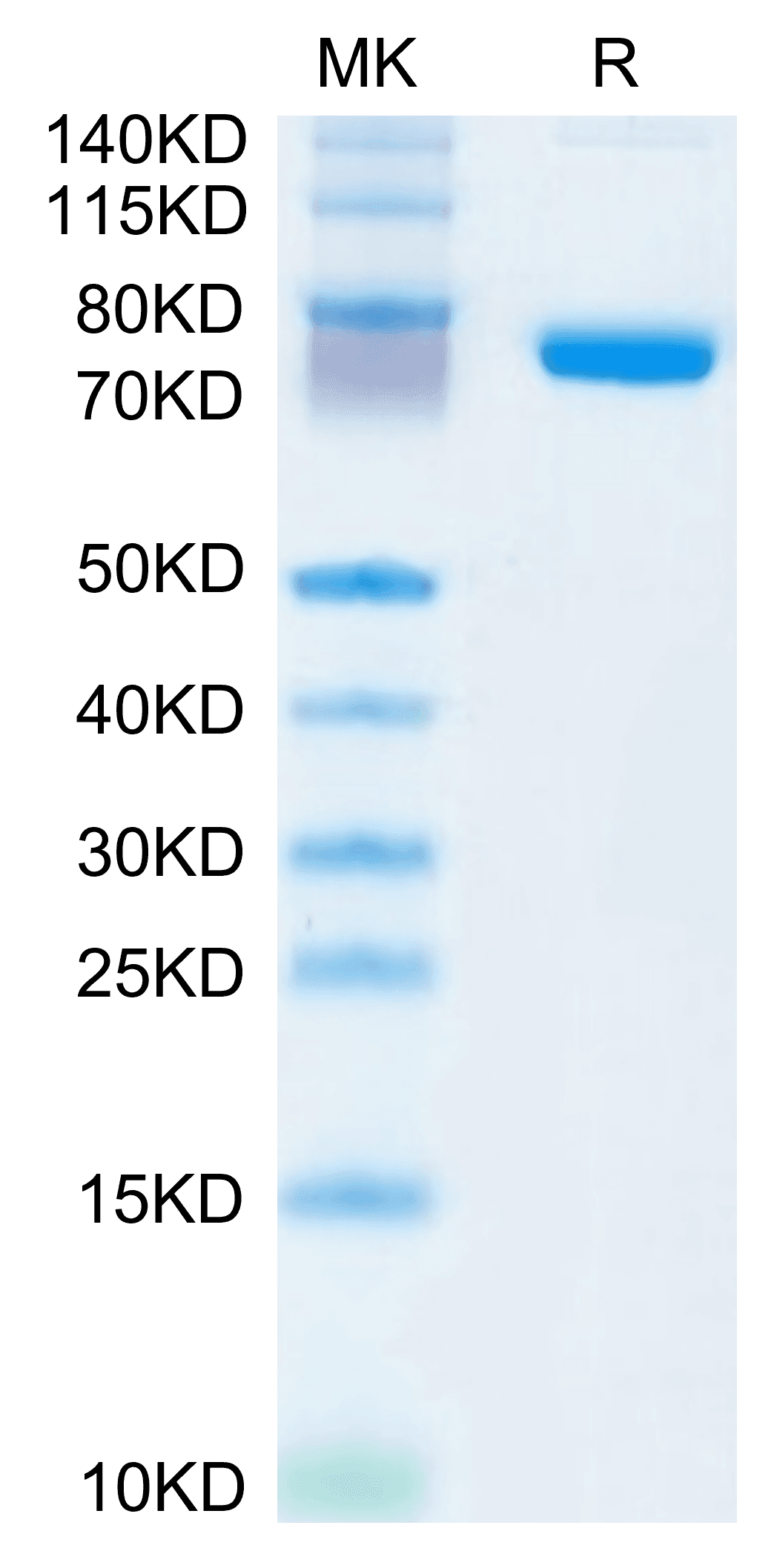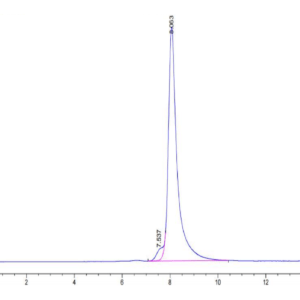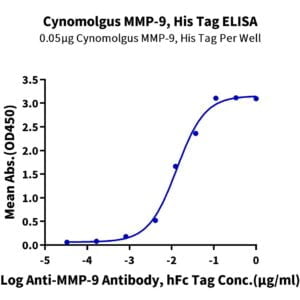| Weight | 1 lbs |
|---|---|
| Dimensions | 9 × 5 × 2 in |
| accession | O75326 |
| express system | HEK293 |
| product tag | C-His |
| purity | > 95% as determined by Tris-Bis PAGE;> 95% as determined by HPLC |
| background | Semaphorin7A (Sema7A) plays an important role in the immunoregulation of the brain.Sema7A is upregulated in the epileptic brain and plays a potential role in the regulation of seizure activity in PTZ-kindled epileptic rats, which may be related to neuroinflammation. Sema7A promotes the inflammatory cytokines TNF-α and IL-6 as well as the growth of mossy fibers through the ERK pathway, suggesting that Sema7A may promote seizures by increasing neuroinflammation and activating pathological neural circuits. Sema7A plays a critical role in epilepsy and could be a potential therapeutic target for this neurological disorder. |
| molecular weight | The protein has a predicted MW of 69.5 kDa. Due to glycosylation, the protein migrates to 70-75 kDa based on Tris-Bis PAGE result. |
| available size | 100 µg, 500 µg |
| endotoxin | Less than 1EU per μg by the LAL method. |
Human SEMA7A Protein 5135
$270.00 – $900.00
Summary
- Expression: HEK293
- Pure: Yes (HPLC)
- Amino Acid Range: Gln45-Ala648
Human SEMA7A Protein 5135
| protein |
|---|
| Size and concentration 100, 500µg and lyophilized |
| Form Lyophilized |
| Storage Instructions Valid for 12 months from date of receipt when stored at -80°C. Recommend to aliquot the protein into smaller quantities for optimal storage. Please minimize freeze-thaw cycles. |
| Storage buffer Shipped at ambient temperature. |
| Purity > 95% as determined by Tris-Bis PAGE |
| target relevance |
|---|
| Semaphorin7A (Sema7A) plays an important role in the immunoregulation of the brain.Sema7A is upregulated in the epileptic brain and plays a potential role in the regulation of seizure activity in PTZ-kindled epileptic rats, which may be related to neuroinflammation. Sema7A promotes the inflammatory cytokines TNF-α and IL-6 as well as the growth of mossy fibers through the ERK pathway, suggesting that Sema7A may promote seizures by increasing neuroinflammation and activating pathological neural circuits. Sema7A plays a critical role in epilepsy and could be a potential therapeutic target for this neurological disorder. |
| Protein names Semaphorin-7A (CDw108) (JMH blood group antigen) (John-Milton-Hargen human blood group Ag) (Semaphorin-K1) (Sema K1) (Semaphorin-L) (Sema L) (CD antigen CD108) |
| Gene names SEMA7A,SEMA7A CD108 SEMAL |
| Protein family Semaphorin family |
| Mass 9606Da |
| Function Plays an important role in integrin-mediated signaling and functions both in regulating cell migration and immune responses. Promotes formation of focal adhesion complexes, activation of the protein kinase PTK2/FAK1 and subsequent phosphorylation of MAPK1 and MAPK3. Promotes production of pro-inflammatory cytokines by monocytes and macrophages. Plays an important role in modulating inflammation and T-cell-mediated immune responses. Promotes axon growth in the embryonic olfactory bulb. Promotes attachment, spreading and dendrite outgrowth in melanocytes. |
| Catalytic activity #N/A |
| Subellular location Cell membrane ; Lipid-anchor, GPI-anchor ; Extracellular side. Note=Detected in a punctate pattern on the cell membrane of basal and supra-basal skin keratinocytes. |
| Tissues Detected in skin keratinocytes and on endothelial cells from skin blood vessels (at protein level). Expressed in fibroblasts, keratinocytes, melanocytes, placenta, testis, ovary, spleen, brain, spinal chord, lung, heart, adrenal gland, lymph nodes, thymus, intestine and kidney. |
| Structure Interacts with ITGA1 and ITGB1 (Probable). Interacts with PLXNC1. |
| Target Relevance information above includes information from UniProt accession: O75326 |
| The UniProt Consortium |
Data
 |
| The purity of Human SEMA7A is greater than 95% as determined by SEC-HPLC. |
 |
| Human SEMA7A on Tris-Bis PAGE under reduced condition. The purity is greater than 95%. |
Publications
Publications
| pmid | title | authors | citation |
|---|---|---|---|
| We haven't added any publications to our database yet. | |||
Protocols
| relevant to this product |
|---|
Documents
| # | ||
|---|---|---|
| Please enter your product and batch number here to retrieve product datasheet, SDS, and QC information. | ||














